 My table at Gen Con, 2022
My table at Gen Con, 2022
I had the amazing opportunity to exhibit at Gen Con this year! It was an incredible experience overall and I’m grateful for the opportunity to learn from both my successes and my mistakes.
If you’re an artist interested in exhibiting at a convention, I wanted to share with you some tips I’ve learned this year that might be helpful to you.
I have written a previous article on things I’ve learned from conventions, you can find that here:
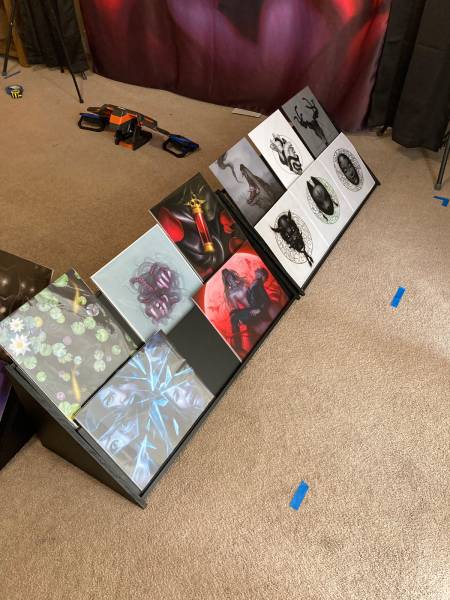
We marked on the floor with tape how big the tables were, as well as the overall booth size. We also set up the prints how we wanted them displayed at the show.
1. Set Up a Trial Run at Home Before the Convention
This is a step that is easy to overlook, but has proven essential to my process of preparing for each convention. I always delayed deciding where to put which prints, as well as the overall layout, until setup the day before. However, this caused me a lot of stress and worry, because I wasn’t giving myself any leeway for measurement mistakes, forgetting prints, layout issues, etc.
Going the extra mile and setting up your booth at home (if you have the space of course) will give you plenty of time to make adjustments, order missing products, and get the decision-making process out of the way, so that once you get to the show, the hard part is over and you know exactly everything to bring and how you want everything to look.
Bonus tip: Take pictures of your setup at home, so that when you get to the show, you know the exact layout of all your products.
2. If You Can Upgrade to a Corner Booth, You Should
This tip comes with a few caveats, of course.
“Can” is subjective to everyone and their situation. Can you realistically afford the cost to upgrade without it making or breaking your entire show? Is it possibly going to put you in an area that gets lower traffic? Do you have the funds to be able to rearrange or purchase new equipment to accommodate a corner space?
Of course, sometimes the answers to these questions will be no, in which case, feel free to pass on this tip for now!
I’ve never had a corner booth before, but I felt like the extra space to display my prints alone made it worth the extra cost, not to mention the increased visibility and not being boxed in by any neighbor booths. I have no regrets about it, and if I’m offered the opportunity to upgrade at future shows, and I can reasonably do so, I will upgrade to a corner booth again and again.
3. Try to Stay Near Other Artists
I’m curious to hear from other artists what their experiences have been like in this situation and if I have it wrong! That being said, I’m offering this tip for a few reasons.
The logic behind this is that people who enjoy art and are willing to spend money on prints will intentionally go out of their way to look for the Artist Alley, or the Art Show, aka the area where most artists exhibit. They go with intention and it makes it easier for them to find the artists they want to support.
Talking to other artists, some of the feedback they’ve mentioned is that they feel like when they aren’t connected near other artists, they tend to get overlooked a little more, or just harder for collectors to find in the sea of miscellaneous exhibitors. They’ve mentioned they found more success when they were located within or closer to the other artists in general.
Being a corner booth located directly outside the art show, we overheard a number of people mentioning to each other that they see the art show up ahead and just aren’t interested in going in that section. It made me wonder how many attendees avoid the art area altogether and if surprising them with seeing artwork in the middle of all the other exhibitors would prove fruitless (because they came for other reasons than buying art).
Please comment below with your experience, whether it contradicts the thoughts I’ve shared or whether it aligns with them, I’m curious to hear if my theory is accurate or not!
5. Practical Tip: Snacks and Meals
Keeping yourself energized and hydrated is very important! Taking care of your body is essential to having a good con experience. I have a few tips I’d like to offer for this category:
- If possible, leave your booth to go eat your bigger meals. Not only does your body need nutrition from your meal, but your brain needs a break from the onslaught of talking and handling orders and social interaction! Leaving your booth, even if it’s just for a few minutes, will allow your brain to relax and focus on your meal so you can return refreshed. If I don’t have a helper at my booth, I will put out a sign that says “Gone to lunch – I’ll be back at (fill in the blank with a time).” You can ask your neighbor to watch your table while you’re gone as well, just to keep an eye on your things.
- Add protein to your snacks and meals! This is very important for that feeling of comfortable fullness so you can focus on talking to attendees and handling transactions without constantly feeling hungry.
- Bring a big water bottle and fill it up intermittently. Staying hydrated throughout the day is SO important. Consider bringing a couple of extra water bottles in case the water fountains aren’t working (this was the case for Gen Con because of covid reasons – understandable of course). I ended up having to purchase $4 water bottles because I kept forgetting to bring some (facepalm moment!). I could have saved a lot of money on this trip if I had just brought my own!
5. Try Something New That Scares You
Is there something you’d like to add to your booth but it makes you feel a little nervous when you think about it? Or maybe a different way you want to try things, but you worry it might not be as profitable?
Pick one or two things you’d like to try, AND TRY IT. Worst case scenario, it doesn’t quite work out and now you have more data as to what works and what doesn’t, which will help you moving forward.
For me, this had to do with offering sketches on Artist Proofs from Magic The Gathering, which I had always found to be rather stressful. Every artist has a different way of handling things, and I was convinced that there was a “right” way and a “wrong” way and that I would unknowingly pick the “wrong” way, only to result in massive negative consequences.
Turns out, there’s (usually) not one right or wrong way, and you can experiment and try things out, and if you find it doesn’t work, you can move on.
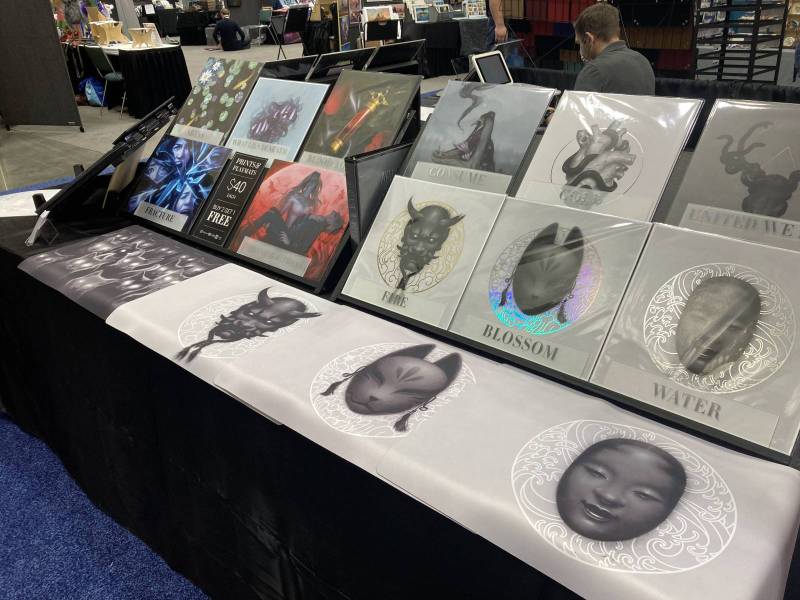
This was our first show trying these types of displays my partner made for the prints. Try something new every time!
6. Try a Tablet Display for Payment
This is, admittedly, a tip that isn’t necessarily the cheapest option, but, if you’re in a financial position to be able to do so, try incorporating some kind of tablet display for payment processing. I use the display from Square, I’m not sure if there are other options available.
This seems really superfluous and extra, but it lends an heir of professionalism to your brand that is important. It made it obvious to customers on how/where to handle transactions because it’s so visible, so it takes the guesswork out of it for them.
As a bonus, there is a “tipping” option that I turned on (it automatically comes up before asking for a signature, I think), which actually really did help a lot and added up a bit over the course of the entire convention. It was one of the things I was reluctant to try (see tip #5 again!), and I know a lot of artists might be uncomfortable with this option, but when you look at it from a consumer standpoint, if you were to buy a print from another artist that you love and there was a chance to add a small tip for their time, you would most likely be glad to offer that kind of support, in a way that concretizes your thanks towards them.
The great part is that this is how most attendees feel about your art, and traveling to conventions can be an expensive process for artists, so this is an easy way to incorporate something that will help pay for your meals and maybe some miscellaneous travel fees.
And, of course, it’s something you don’t have to have either. It’s up to you!
7. If You Do Commissions, Finish them BEFORE the Show
If you incorporate commissions into your shows at all, please, PLEASE, for the love of all that is good, finish them before the show. There is nothing worse than finishing a long day at the show, managing to finally grab some food, drag yourself back to the hotel room, exhausted and drained, only to have to pull out your pencils and paintbrushes and start working on a commission.
Conventions are very draining, both physically and mentally (anyone else feel like this??), and creating art can require a lot of that mental and creative energy. Your time would be better spent getting adequate sleep and relaxation so you can feel restored and refreshed for the next busy day.
Almost every night, once I got back to the hotel room, I drew more originals on the backs of the Artist Proofs, which did end up being a larger portion of our gross income than I thought it would (I had no idea how many to bring, turns out I didn’t bring enough!). However, that experience only solidified the rule that you shouldn’t put that time commitment (and energy commitment) on yourself during the show if you don’t have to.
Maybe other artists don’t have a problem with this and like that process and it works for them – if so, awesome! I wish I could do the same, haha.
Bonus Tip: Bring a Collapsible Cart (or two) on the Morning of the Last Day
Maybe this bonus tip is obvious for seasoned pros, or for artists who have been doing this a lot more than me, but we made the mistake of trying to go through the waiting yard/docks for load-out, and MAN that was a mistake. Not sure if this is common with many conventions, but we wasted a lot of time just waiting in line, when we could have loaded everything up and walked a lot sooner. There are dolly carts that you can fold up flat, so they’re easy to transport – they just make life a lot easier in general, both for load-in and load-out. I highly recommend them!
That’s everything I have for now! Let me know your thoughts in the comments and if any of these have been helpful or if your experiences have differed from mine on any of these points.
Thanks for reading!
– Miranda


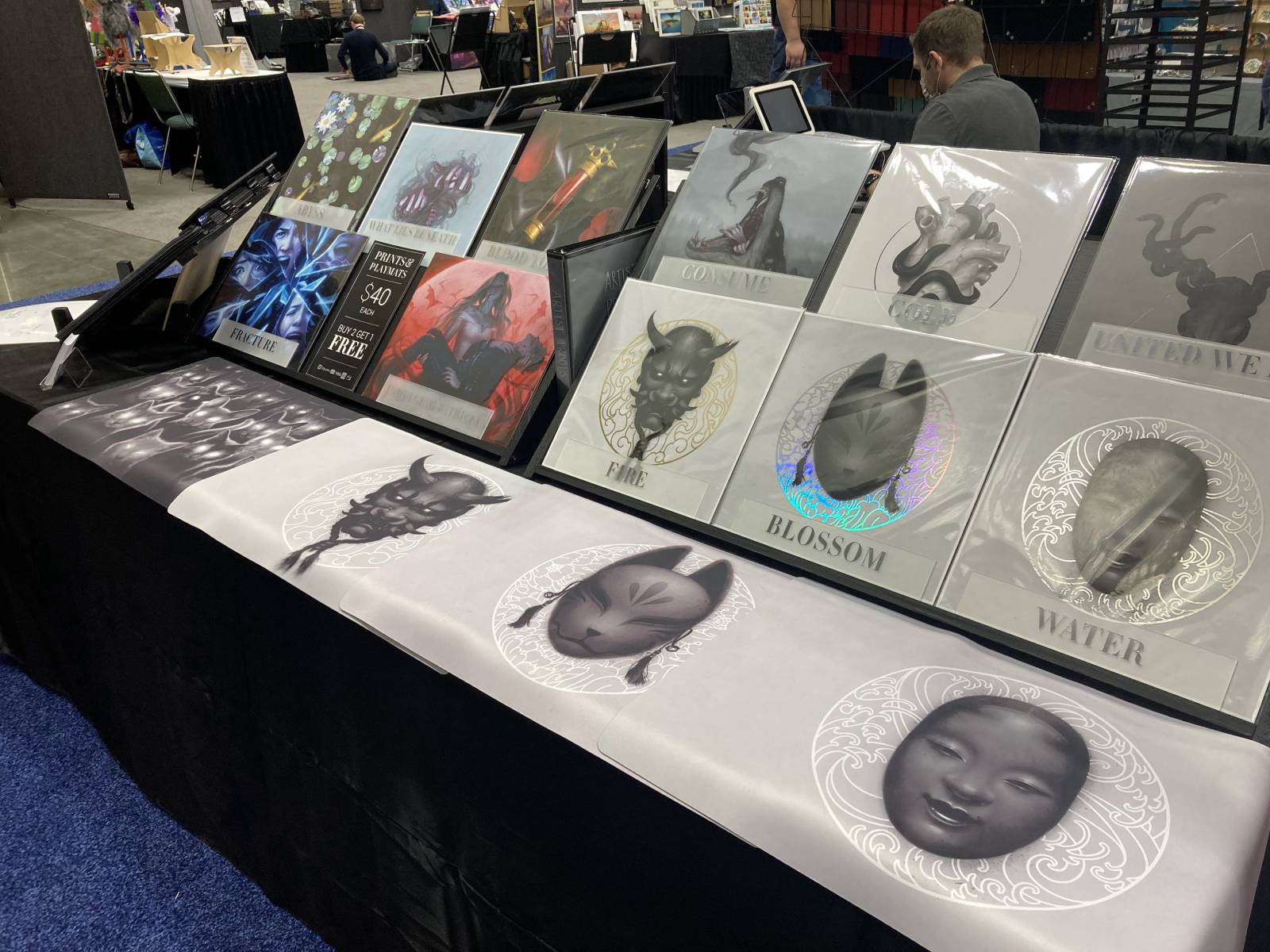
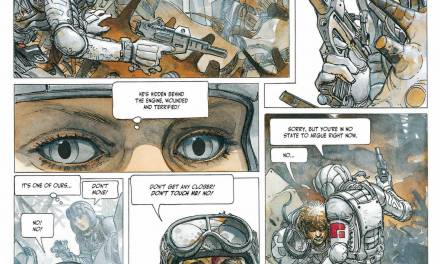

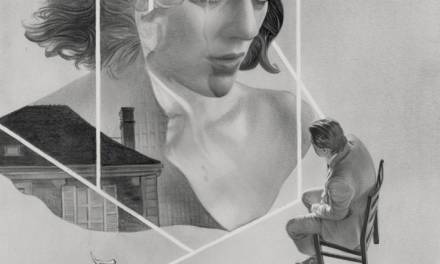
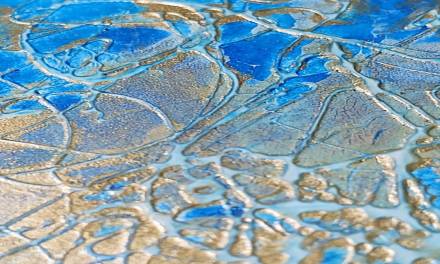
Wow! This is so nice to read, just to see what you and other artists have to go through. It always looks like everyone goes through so much hard work to set up your stalls beautifully and we’re the lucky ones who get to see your beautiful stalls and wares!
Thank you for the insight! (And tips if ever we make it!)